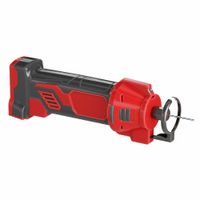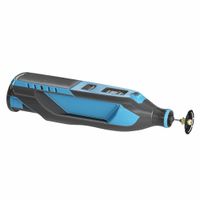Call +(254) 703 030 000 / 751 483 999 / 721 704 777
- Home
- Tools
- Power Tools
- Rotary Tools Oscillating Tools Cut Out Tools
.....Read More
Frequently Asked Questions
What are the best rotary tools for detailed sanding and engraving?
The best rotary tools for detailed sanding and engraving are:
1. **Dremel 4300**: Known for its versatility and power, the Dremel 4300 offers a variable speed range of 5,000 to 35,000 RPM, making it suitable for both delicate and heavy-duty tasks. It features a pivot light for enhanced visibility and a universal 3-jaw chuck that accommodates all Dremel accessory shank sizes.
2. **Dremel 8220**: This cordless model provides the convenience of portability without sacrificing performance. It operates at speeds from 5,000 to 30,000 RPM and comes with a 12V lithium-ion battery, ensuring long-lasting power. Its ergonomic design and lightweight build make it ideal for precision work.
3. **WEN 2305**: A budget-friendly option, the WEN 2305 offers variable speeds from 8,000 to 30,000 RPM. It includes a flex shaft for intricate detailing and a wide array of accessories, making it a versatile choice for both sanding and engraving.
4. **Proxxon 38481 IB/E**: This tool is designed for precision with a variable speed range of 5,000 to 20,000 RPM. It is lightweight and compact, making it perfect for detailed work. The Proxxon is known for its quiet operation and high-quality build, suitable for professional use.
5. **Tacklife RTD35ACL**: This rotary tool offers a powerful 1.8-amp motor with a speed range of 10,000 to 32,000 RPM. It includes a flexible shaft and a wide range of accessories, providing excellent control for detailed tasks.
These tools are highly regarded for their precision, versatility, and reliability, making them ideal for detailed sanding and engraving projects.
How do oscillating tools compare to rotary tools for surface prep?
Oscillating tools and rotary tools each have distinct advantages and limitations when it comes to surface preparation.
Oscillating tools operate with a back-and-forth motion, making them highly versatile for detailed work. They are excellent for tasks requiring precision, such as removing grout, cutting drywall, or sanding in tight spaces. Their design allows for easy access to corners and edges, which is beneficial for surface prep in confined or awkward areas. Oscillating tools are generally safer to use on delicate surfaces due to their controlled motion, reducing the risk of over-sanding or damaging the material.
Rotary tools, on the other hand, use a spinning motion and are typically more powerful, making them suitable for heavy-duty tasks. They excel in removing large amounts of material quickly, such as grinding down metal or smoothing rough wood surfaces. Rotary tools are ideal for large, flat areas where speed and efficiency are prioritized. However, their high-speed rotation can make them less precise and more challenging to control in detailed work, increasing the risk of accidental damage to the surface.
In terms of versatility, oscillating tools often come with a wider range of attachments for various tasks, while rotary tools are more limited in this regard. However, rotary tools can handle tougher materials due to their power.
Ultimately, the choice between oscillating and rotary tools for surface preparation depends on the specific requirements of the task. For precision and versatility in tight spaces, oscillating tools are preferable. For speed and power on larger surfaces, rotary tools are more effective.
What attachments are essential for cut-out tools when working with drywall?
When working with drywall using cut-out tools, several essential attachments are necessary to ensure precision, efficiency, and safety:
1. **Drywall Cutting Bits**: These are specifically designed for cutting through drywall. They come in various sizes and shapes, such as spiral or straight bits, to accommodate different cutting needs, like making straight cuts or intricate shapes.
2. **Guidepoint Bits**: These bits have a pointed tip that helps in guiding the cut along the edge of an electrical box or other fixtures, ensuring precise and clean cuts without damaging the surrounding material.
3. **Dust Extraction Attachments**: These are crucial for maintaining a clean work environment and reducing airborne dust. They connect to a vacuum system to capture dust directly from the cutting area, improving visibility and air quality.
4. **Depth Guides**: These attachments help control the depth of the cut, preventing accidental cuts into wires or other materials behind the drywall. They are adjustable and ensure consistent cutting depth.
5. **Circle Cutters**: For tasks that require circular cuts, such as installing recessed lighting, circle cutter attachments are essential. They allow for precise, adjustable circular cuts without the need for additional tools.
6. **Sanding Attachments**: After cutting, sanding attachments can be used to smooth out rough edges, ensuring a clean finish and preparing the surface for painting or further work.
7. **Safety Guards**: These attachments protect the user from debris and accidental contact with the cutting bit, enhancing safety during operation.
8. **Multi-Purpose Blades**: For versatility, some cut-out tools can be equipped with multi-purpose blades that can handle various materials, including drywall, wood, and plastic, making them useful for different stages of a project.
These attachments enhance the functionality and safety of cut-out tools, making them indispensable for drywall work.
Can oscillating tools be used for precise sanding and polishing?
Yes, oscillating tools can be used for precise sanding and polishing, but with some limitations. These versatile tools are equipped with a variety of attachments, including sanding pads and polishing accessories, which allow them to perform a range of tasks. For precise sanding, oscillating tools are particularly effective in tight spaces, corners, and edges where larger sanders cannot reach. The oscillating motion provides control and reduces the risk of over-sanding, making it suitable for detailed work.
However, the precision of sanding with an oscillating tool depends on the quality of the attachment and the skill of the user. Fine-grit sandpaper attachments can achieve a smooth finish, but the tool's relatively small surface area means it may take longer to sand large surfaces compared to dedicated sanders. For polishing, oscillating tools can be fitted with polishing pads to buff and shine surfaces. They are effective for small areas and intricate details, but may not provide the same level of finish as specialized polishers on larger surfaces.
In summary, while oscillating tools offer versatility and can be used for precise sanding and polishing, they are best suited for small, detailed tasks rather than large-scale projects. The choice of attachment and user proficiency play significant roles in achieving the desired results.
What safety precautions should be taken when using rotary tools?
When using rotary tools, several safety precautions are essential to prevent accidents and ensure safe operation:
1. **Personal Protective Equipment (PPE):** Always wear safety goggles to protect your eyes from flying debris. Use a dust mask or respirator to avoid inhaling dust and particles. Wear hearing protection if the tool is loud, and use gloves to protect your hands from sharp objects and vibrations.
2. **Proper Clothing:** Avoid loose clothing, jewelry, or long hair that could get caught in the tool. Wear fitted clothing and tie back long hair.
3. **Tool Inspection:** Before use, inspect the rotary tool for any damage or wear. Check the power cord for frays and ensure all attachments are secure.
4. **Work Area:** Keep the work area clean and well-lit. Remove any unnecessary objects that could cause tripping or distractions.
5. **Secure Workpiece:** Ensure the material you are working on is securely clamped or held in place to prevent movement during operation.
6. **Correct Attachments:** Use the right attachment for the task and ensure it is properly installed. Do not use damaged or worn-out bits.
7. **Tool Handling:** Hold the tool firmly with both hands and maintain a stable stance. Do not apply excessive pressure; let the tool do the work.
8. **Ventilation:** Work in a well-ventilated area to avoid inhaling dust and fumes.
9. **Power Source:** Ensure the tool is unplugged when changing attachments or making adjustments. Use a ground fault circuit interrupter (GFCI) outlet to prevent electrical shocks.
10. **Follow Manufacturer’s Instructions:** Always read and follow the manufacturer’s guidelines and safety instructions specific to your rotary tool model.
11. **Emergency Preparedness:** Be aware of the location of the power switch and have a plan in case of an emergency, such as knowing where the first aid kit and fire extinguisher are located.
How do you choose the right bit for a cut-out tool?
To choose the right bit for a cut-out tool, consider the following factors:
1. **Material Type**: Identify the material you will be cutting. Different bits are designed for specific materials such as drywall, wood, metal, or tile. For example, carbide-tipped bits are suitable for harder materials like tile and metal, while high-speed steel bits work well for softer materials like wood and drywall.
2. **Bit Shape and Design**: The shape of the bit affects the type of cut it can make. Spiral bits are ideal for plunge cuts and provide a clean finish, while straight bits are better for edge cutting. Consider the design based on the precision and type of cut required.
3. **Bit Size**: Choose the appropriate diameter and length of the bit based on the thickness of the material and the depth of the cut needed. Ensure the bit is long enough to penetrate through the material without being too long, which can cause instability.
4. **Cutting Speed**: Different bits are designed to operate at specific speeds. Check the recommended RPM (revolutions per minute) for the bit and ensure your tool can accommodate it. Using the wrong speed can lead to poor cuts or damage to the bit.
5. **Durability and Quality**: Invest in high-quality bits from reputable manufacturers to ensure durability and performance. Cheaper bits may wear out quickly or break, especially when used on tougher materials.
6. **Compatibility**: Ensure the bit is compatible with your cut-out tool. Check the shank size and type to match your tool’s collet or chuck.
7. **Project Requirements**: Consider the specific requirements of your project, such as the need for precision, speed, or specific cut types, and choose a bit that meets these needs.
By evaluating these factors, you can select the right bit for your cut-out tool, ensuring efficiency and quality in your work.
What are the advantages of using an oscillating tool for scraping tasks?
An oscillating tool offers several advantages for scraping tasks:
1. **Versatility**: Oscillating tools can accommodate a variety of attachments, making them suitable for different scraping tasks, such as removing paint, adhesives, or caulk. This versatility reduces the need for multiple specialized tools.
2. **Precision**: The oscillating motion allows for precise control, enabling users to scrape in tight spaces or around delicate surfaces without causing damage. This precision is particularly beneficial for detailed work or when working near edges.
3. **Efficiency**: The rapid oscillation speeds up the scraping process, making it more efficient than manual scraping. This can significantly reduce the time and effort required for large or stubborn scraping tasks.
4. **Reduced Fatigue**: The tool's motorized action minimizes the physical effort needed, reducing user fatigue during prolonged use. This is especially advantageous for professionals or DIY enthusiasts working on extensive projects.
5. **Safety**: The oscillating motion is less likely to cause injury compared to traditional scraping tools, as the blade does not spin or rotate. This reduces the risk of accidental cuts or damage to the work surface.
6. **Dust Control**: Many oscillating tools come with dust extraction attachments, helping to maintain a cleaner work environment by minimizing dust and debris during scraping.
7. **Accessibility**: The compact design of oscillating tools allows them to reach areas that are difficult to access with larger tools, such as corners, crevices, or behind fixtures.
8. **Durability**: High-quality oscillating tools are built to withstand rigorous use, providing a long-lasting solution for frequent scraping tasks.
Overall, the oscillating tool's combination of versatility, precision, and efficiency makes it an excellent choice for a wide range of scraping applications.


